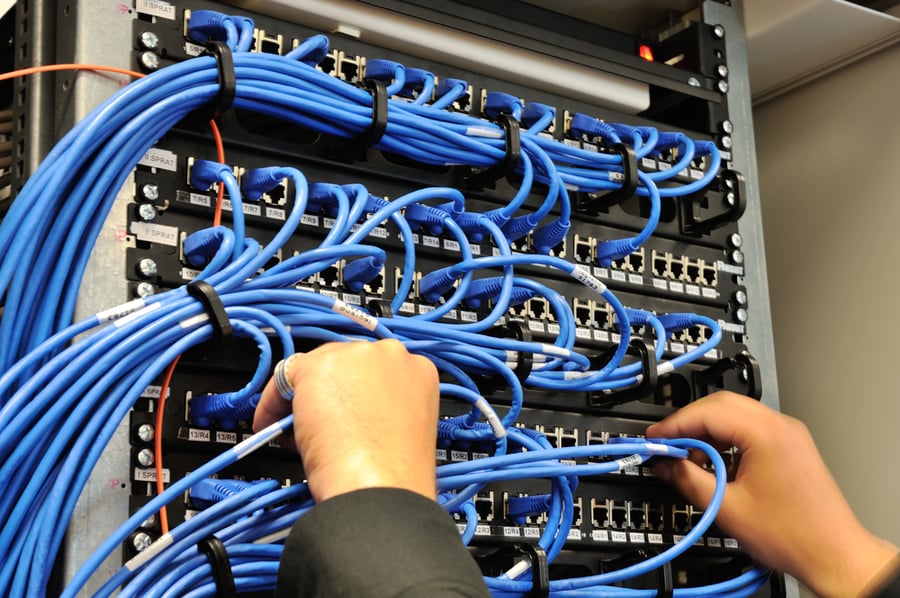Understanding Telecommunications Industry Association (TIA) Standards

We live, work, and play in a connected world but that would not be possible if there were not a set of standards to guide the installation, maintenance and testing of products and technologies.
The Telecommunications Industry Association (TIA) is responsible for the voluntary standards for telecommunications cabling infrastructure in user-owned buildings, such as commercial buildings, residential buildings, homes, data centers, and industrial buildings.
TIA’s Engineering Committee TR-42 develops and maintains these standards.
“The generic cabling topologies, design, distances and outlet configurations as well as specifics for these locations are addressed,” according to the TIA Engineering Committee TR-42. “The committee’s standards work covers requirements for copper and optical fiber cabling components (such as cables, connectors and cable assemblies), installation, and field testing in addition to the administration, pathways and spaces to support the cabling.”
Telecommunication standards are important as they:
- Increase productivity
- Create operational efficiencies
- Support mission-critical applications
- Provide critical uptime
- Promote multi-manufacturer environments by allowing open architecture systems
Thanks to standards, organizations can choose the best solutions that fit their needs. The lifespan of infrastructure is extended as standards support best practices which support existing and future telecommunication systems.
What is TIA and ANSI?
The Telecommunications Industry Association (TIA) traces its roots back to 1924, but was officially founded in 1988 with the merger of the United States Telecommunications Suppliers Association (USTSA) and the information and Telecommunications Technologies Group of the Electric Industries Association (EIA).
The group has a global membership of more than 400 companies spanning information and communication technology manufacturers and suppliers, network operators and service providers, distributors, and systems integrators.
TIA is accredited by the American National Standards Institute (ANSI), which oversees the development of voluntary standards for products, services, processes, systems, and personnel in the United States.
Standards for telecommunications start with the ANSI/TIA prefix as in “ANSI/TIA-568.0-E Generic Telecommunications Cabling for Customer Premises”.
TIA’s Standards and Technology Department operates engineering committees which develop standards for:
- TR-8 Mobile and Personal Private Radio Standards
- TR-14 Structural Standards for Communication and Small Wind Turbine Support Structures
- TR-34 Satellite Equipment and Systems
- TR-41 Performance and Accessibility for Communications Products
- TR-42 Telecommunications Cabling Systems
- TR-45 Mobile and Point-to-Point Communications Standards
- TR-48 Vehicular Telematics
- TR-50 M2M-Smart Device Communications
- TR-51 Smart Utility Networks
- TR-60 ICT Lifecycle Management
Breakdown of TIA Standards for Telecommunications Cabling
TIA’s standards for telecommunications cabling infrastructure falls into three main categories:
- Common
- Premises
- Component
The key standards that can be found under those three categories include:
Common Standards
- ANSI/TIA-568.0-E Generic Telecommunications Cabling for Customer Premises
- ANSI/TIA-569-E Telecommunications Pathways and Spaces
- ANSI/TIA-606-C Administration Standard Telecommunications Infrastructure
- ANSI/TIA-607-D Generic Telecommunications Bonding and Grounding (Earthing) for Customer Premises
- ANSI/TIA-862-B Structured Cabling Infrastructure Standard for Intelligent Building Systems
Premises Standards
- ANSI/TIA-568.1-E Commercial Building Telecommunications Infrastructure Standard
- ANSI/TIA-570-D Residential Telecommunications Infrastructure Standard
- ANSI/TIA-758-B Customer-Owned Outside Plant Telecommunications Infrastructure Standard
- ANSI/TIA-942-B Telecommunications Infrastructure Standard for Data Centers
- ANSI/TIA-1005-A Telecommunications Infrastructure Standard for Industrial Premises
Component Standards
- ANSI/TIA-568.2-D Balanced Twisted-Pair Telecommunications Cabling and Components
- ANSI/TIA-568.3-D Optical Fiber Cabling Components
- ANSI/TIA-568.4-D Broadband Coaxial Cabling and Components
Optical Fiber Cabling Component Standards
TIA’s “Optical Fiber Cabling Component Standard” was first developed in 1991, known today as ANSI/TIA-568.3
According to TIA’s Fiber Optics Tech Consortium, “The bulk of the standards define cabling types, distances, connectors, cable system architectures, cable termination standards and performance characteristics, cable installation requirements and methods of testing installed cable.”
The standard was revised in 1995 (revision B), and again in 2009 (revision C) and finally in 2016 with the publishing of ANSI/TIA-568.3-D.
TIA is currently crafting new guidelines that will be released as ANSI/TIA-568.3-E likely sometime later this year or in 2022.
Understanding ANSI/TIA-568.3-D
ANSI/TIA-568.3-D is the standard that specifies performance and transmission requirements for premises optical fiber cable, connectors, connecting hardware, and patch cords.
Transition methods used to maintain optical fiber polarity and ensure connectivity between transmitters and receivers using simplex, duplex, and array connectivity are also described.
ANSI/TIA-568.3-D is grouped with 568.1 which defines general cabling requirements; 568.2 which focuses on components of balanced twisted-pair cable systems; and 568.4 which addresses coaxial cabling components.
The standards of ANSI/TIA-568.3-D are divided into the following sections:
- Optical Fiber Cabling Components
- Optical Fiber Connectors
- Color Identification
- Optical Fiber Telecommunications Outlet Required Features
- Optical Fiber Splices, Fusion or Mechanical
- Optical Fiber Connector (Mated Pair)
- Patch Cords
Latest ANSI/TIA-568.3-D Highlights
According to the Standards Informant, significant changes from revision C to revision D for ANSI/TIA-568.3 included:
- The polarity of cords and connectivity methods supporting parallel optical signals for transceiver interfaces and array connector patch cords and cables that exclusively employ two rows of fibers per plug are described.
- Array connectivity of arbitrary row width following patterns of the illustrated 12‑fiber row components are allowed.
- Specifications for wideband multimode fiber (commonly referred to as “OM5”) have been added.
- The use of OM1, OM2, and OS1 cables is no longer recommended.
- The maximum allowable OM3 and OM4 attenuation at 850 nm has been lowered to 3.0 dB/km.
- The minimum return loss of single mode connections and splices has been raised from 26 dB to 35 dB.
- Encircled flux launch conditions are specified for testing multimode connector performance at 850 nm.
- Multimode connector performance is no longer specified at 1300 nm.
Contact DCS today to learn how our “true structured cabling” solutions can help your data center meet the demands of today and tomorrow.
Subscribe to News
Recent posts
LATEST NEWS
Thursday December 7, 2023
Wednesday February 3, 2021







